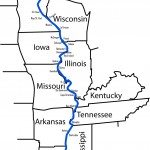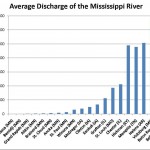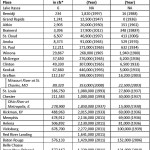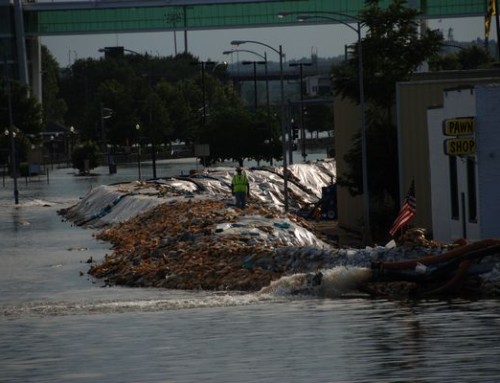The Mississippi River begins in northern Minnesota and travels about 2,350 miles before emptying into the Gulf of Mexico. Thirty percent of its length is in Minnesota. Measurements of the river’s length vary depending upon when they were taken. Before the river was channelized for navigation, the Mississippi would regularly cut new paths and abandon old ones, so the length was always changing.
 The name “Mississippi” is derived from one of the Ojibwe words for the river: “Misi ziibi” (long river). The Ojibwe were intimately familiar with the river and had names to mark different spots. The short channel that connects Lakes Irving and Bemidji was called Wub’-i-gum-ag zi’-bi (the river of the lake that has a constrictive place), while between Lakes Cass and Winnibigoshish, there was a spot called Ueshk’-i-bwa-kan–ing (at the place of artichokes).
The name “Mississippi” is derived from one of the Ojibwe words for the river: “Misi ziibi” (long river). The Ojibwe were intimately familiar with the river and had names to mark different spots. The short channel that connects Lakes Irving and Bemidji was called Wub’-i-gum-ag zi’-bi (the river of the lake that has a constrictive place), while between Lakes Cass and Winnibigoshish, there was a spot called Ueshk’-i-bwa-kan–ing (at the place of artichokes).
The Mississippi River has the third largest watershed in the world, draining 41% (1.25 million square miles) of the US (excluding Alaska and Hawaii), including parts of 32 states and two Canadian provinces; a drop of water from as far away as New York or Montana will end up in the Mississippi River.
For the past 10,000 years, the Mississippi River has emerged from an outlet at Lake Itasca in northern Minnesota, a body of water the Ojibwe called O-mush-ko’zo za-gai-i-gun; the French translated this as Lac la Biche or Elk Lake, but the Elk Lake you’ll find today south of Lake Itasca is a different body of water that the Ojibwe call Man-i-do za’-gai-i-gun (the spirit’s lake ). When Henry Schoolcraft reached the source of the Mississippi in 1832, aided greatly by his Ojibwe guide, Ozawindib, he came up with the name “Itasca” from the Latin phrase “veritas caput”, which he translated as “true head.”
The spot where the river emerges from Lake Itasca today looks different than it did before the 1930s, when workers from the Civilian Conservation Corps, a Depression-era public works program, initiated a project to stabilize the area and make it look prettier. Before this project, the area was wild and marshy, so it was hard to tell where the river actually began. The CCC built a 44-foot long, 7-foot wide concrete dam and covered it with rocks to make the remade river outlet look natural.
The Mississippi has several distinct segments. Through the Headwaters area, a stretch of nearly 500 miles, the Mississippi is a marshy stream that gradually widens into a shallow, rocky river. The only gorge along the Mississippi is the narrow passage it cuts through the Twin Cities below the Falls of St. Anthony.
South of the Falls, the Upper Mississippi runs for 950 miles to the confluence with the Ohio River at Cairo, Illinois. The Upper Mississippi is defined by a range of limestone bluffs that were carved by water from melting glaciers at the end of the last ice age. As the glaciers melted, water stretched from bluff to bluff, forming a glacio-fluvial spillway (known as Glacial River Warren) that cut deeper and deeper into the landscape. The bluffs are composed of layers of easily eroded sandstone at the base and dolostone at the top, a form of limestone that doesn’t erode as easily. As water washed away the lower layers of sandstone, chunks of the dolostone cleaved off, giving us the dramatic vertical bluff faces we see today along the upper river.
The valley along the upper river is as narrow as 1¼ miles at Prescott and as wide as 6 miles at Trempealeau; the tallest bluffs are around Great River Bluffs State Park near Dakota, Minnesota and lowest around Prescott, Wisconsin.
The riverbed of the Upper Mississippi River is composed of a thin layer of clay, silt, loam, and sand atop a stratum of glacial outwash that is 150’ to 200’ deep; you have to go through a lot of sand and silt deposits to reach bedrock. There are several places where natural terraces formed that are well above the river. Most of the village of Pepin (Wisconsin) is on a terrace 45 feet above the river; Trempealeau (Wisconsin) is 60’ above the river.
Much of the Upper Mississippi passes through the heart of the Driftless Area, 15,000 square miles in Minnesota, Wisconsin, Iowa, and Illinois that escaped glacial flows of the past two million years. This area has no glacial drift (the rocky debris deposited by glaciers), hence the name Driftless Area. Unlike surrounding areas that were primarily flat prairies and forests, the Driftless Area is a landscape of steep cliffs, rolling hills, and deep valleys, much of it carved by melting water as the glaciers retreated.
Some folks identify a stretch called the Middle Mississippi River that flows from the confluence of the Missouri River near Alton, Illinois to the Ohio River confluence at Cairo. As you travel south of St. Louis, this is the first stretch of river that is not dammed and the volume of water is much greater thanks to the Missouri River.
The Lower Mississippi River begins at Cairo, Illinois and ends at the Gulf of Mexico, a distance of nearly 1,000 river miles, meandering through sub-tropical swamps and forests rife with wildlife before fanning out into a lush delta at the edge of the Gulf that the Mississippi River built over the past 7,000 years. There are no dams along this stretch but tall levees and bank stabilization efforts have confined the river to a fairly narrow channel. Along the lower Mississippi River, the original floodplain extends up to 100 miles in places.
Water Volume
The Mississippi River grows from a small forest stream in northern Minnesota to a watery behemoth along the latter part of its course. At Lake Itasca, the Mississippi River’s average discharge is about six cubic feet/second (cfs) or roughly 45 gallons of water. By the time the river reaches St. Paul (Minnesota), its average flow has increased to about 12,000 cfs or 90,000 gallons of water. At Clinton (Iowa), just upstream from the Quad Cities, the average flow has increased four-fold to about 49,000 cfs.
After adding water from the Illinois River, the average flow of the Mississippi River at Grafton (Illinois) jumps to 112,000 cfs, then jumps to 187,000 cfs at St. Louis after the merge with the Missouri River. At Hickman (Kentucky), the average flow is 489,000 cfs or 2 ½ times the flow at St. Louis, with most of the increase coming from the joining of the Ohio River with the Mississippi. You’ll generally find the highest volume of water in the Mississippi River from Vicksburg south to Red River Landing. At Vicksburg the average flow of the Mississippi River is 679,000 cfs, which is over 100,000 times greater than the flow at Lake Itasca!
At Red River Landing, a chunk of the river’s volume diverts down the Atchafalaya River, so the average flow at Baton Rouge (576,000 cfs) is less than places upstream. The flow of the Mississippi River is spread out even more as it spiderwebs its way through the Louisiana Delta to the Gulf of Mexico.
The numbers above, though, only speak to the average volume of water in the river. For a more complete picture of the capacity of the river, check out the table to the left that shows the highest and lowest recorded flows for different places along the Mississippi. You’ll notice that these extreme variations can run up to ten times as high as the average flow or as low as one-tenth of it. These numbers also give you a sense of the capacity of the lower river versus the upper river. The record flow at St. Louis of roughly one million cubic feet per second (in 1844 and 1993) is just twice the average flow at Memphis; while folks at Memphis would probably notice the extra water passing by, it would not cause significant flooding. But, if the Ohio River is running high, folks in Memphis will rightly begin making preparations to protect themselves.
The Geeky Stuff
- Length: Strictly in terms of length, the combined Mississippi-Missouri River system is 3,710 miles long (5,970 km) and is the 4th longest in the world after the Nile (4,160 miles/6,693 km), Amazon (4,000 miles/6,436 km), and Yangtze (3,964 miles/6,378km) Rivers.
“Therefore, the Mississippi between Cairo and New Orleans was twelve hundred and fifteen miles long one hundred and seventy-six years ago. It was eleven hundred and eighty after the cut-off of 1722. It was one thousand and forty after the American Bend cut-off. It has lost sixty-seven miles since. Consequently its length is only nine hundred and seventy-three miles at present…
In the space of one hundred and seventy-six years the Lower Mississippi has shortened itself two hundred and forty-two miles. That is an average of a trifle over one mile and a third per year. Therefore, any calm person, who is not blind or idiotic, can see that in the Old Oolitic Silurian Period,’ just a million years ago next November, the Lower Mississippi River was upwards of one million three hundred thousand miles long, and stuck out over the Gulf of Mexico like a fishing-rod. And by the same token any person can see that seven hundred and forty-two years from now the Lower Mississippi will be only a mile and three-quarters long, and Cairo and New Orleans will have joined their streets together, and be plodding comfortably along under a single mayor and a mutual board of aldermen. There is something fascinating about science. One gets such wholesale returns of conjecture out of such a trifling investment of fact.”
Mark Twain, Life on the Mississippi
- Width: At its source, the Mississippi River is about 20 feet wide. You’ll hear many claims from folks stating that this section or that section of the river is the widest part of the Mississippi. The river is, in fact, much wider in most places today than it was before the lock and dam system was built on the upper river. The widest spot today is just north of Clinton, Iowa where the river is 3 miles wide. When the river ran naturally, the widest part was at Lake Pepin, which has a maximum width of 2½ miles. If you include the lakes in northern Minnesota through which the river passes, then the widest spot is actually Lake Winnibigoshish, which stretches up to 11 miles wide.
- Speed: At the headwaters, the river’s surface speed is 1.2 miles per hour, while at New Orleans it is usually around 3 miles per hour. On the lakes in northern Minnesota and on Lake Pepin there is very little current. Just ask the folks who’ve tried canoeing on these sections.
- Volume (discharge): At the Headwaters, the Mississippi River’s average volume is 6 cubic feet per second. (One cubic foot of water is about 7 1/2 gallons.) Downriver, the average volume increases to 12,000 cubic feet per second at the Twin Cities, 186,000 cubic feet per second at St. Louis, and 600,000 cubic feet per second at New Orleans. In the flood of 1993, the river recorded a volume of 1,080,000 cubic feet per second at St. Louis.
- Depth: At the Headwaters, the Mississippi is 3 feet deep; depths vary widely along the river. Through Lake Pepin, the river averages 20-32 feet deep. Before the lock and dam system was built, sections of the Upper Mississippi south of Lake Pepin were sometimes shallow enough in late summer that people could walk from one bank to the other. Today, the US Army Corps of Engineers maintains a channel deep enough for commercial navigation. Although it is called the “9 foot channel”, the average depth in the main channel is typically closer to 12 feet. Away from the main channel, however, the water can still be very shallow. South of Cairo (Illinois), where the Ohio River joins the Mississippi, the river averages 50-100 feet deep. The deepest point along the river is at New Orleans (near Algiers Point) where it reaches 200 feet deep.
- Major tributaries of the Mississippi River include the following rivers: Minnesota, St. Croix, Chippewa, Wisconsin, Des Moines, Illinois, Missouri, Ohio, and Arkansas.
- Ten states border the Mississippi River: Minnesota, Wisconsin, Iowa, Illinois, Missouri, Arkansas, Kentucky, Tennessee, Mississippi, and Louisiana.
- Drainage: The entire Mississippi River watershed is about 1.2 million square miles but much of that comes from the Missouri and Ohio Rivers:
-
- The Upper Mississippi River–Headwaters to the Missouri River– drains 171,500 mi2 (444,300 km2);
- The Missouri River drains 530,000 mi2 (1,373,000 km2);; and
- The Ohio River drains 202,000 mi2 (523,000 km2).
-
Community-supported writing
If you like the content at the Mississippi Valley Traveler, please consider showing your support by making a one-time contribution or by subscribing through Patreon. Book sales don’t fully cover my costs, and I don’t have deep corporate pockets bankrolling my work. I’m a freelance writer bringing you stories about life along the Mississippi River. I need your help to keep this going. Every dollar you contribute makes it possible for me to continue sharing stories about America’s Greatest River!
Continue to Plants and Animals…
© Dean Klinkenberg, 2011, 2012, 2014, 2018






Hi, Damon.
Thanks for the question. I really have no idea how that works. I imagine that someone within the military would make that decision. You might send a question to the public information bureau of the Navy and see what happens.
Good luck!
Dean
Could the LCS USS St Louis have it’s commissioning at St Louis? If not what would have to happen to make that a reality?
Well that’s embarrassing. It’s fixed now. Thanks for pointing out the error!
Dean
better revise your statistics a cubic ft of water is how many gallons? Scott